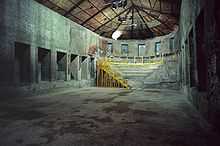Gardens of Maecenas



The Gardens of Maecenas, built by the Augustan-era patron of the arts Gaius Maecenas, were the first gardens in the Hellenistic-Persian garden style in Rome. He sited them on the Esquiline Hill, atop the Servian Wall (agger) and its adjoining necropolis, near the gardens of Lamia.
Site
It is not easy to reconcile the indications of the ancient literature or to determine their exact location. Topographers are not agreed as to whether they lay on both sides of the Servian Wall and both north and south of the porta Esquilina. Many of the burial pits of the ancient necropolis have been found near the north-west corner of the Piazza Vittorio Emanuele, that is, outside the porta Esquilina and the Servian Wall, and north of the via Tiburtina vetus, and probably the horti extended north from this gate and road on both sides of the agger[1]
Facilities
Maecenas is said to have been the first to construct a swimming bath of hot water in Rome,[2] which may have been in the gardens. Whether the horti Maecenatiani bought by Fronto[3] were the former gardens of Maecenas, or called so for some other reason, is unknown, and the domus Frontoniana mentioned in the twelfth century in the topographical guide to Rome by Magister Gregorius may also refer to them [4]
The garden contained terraces, libraries and other aspects of Roman culture, and incurred the displeasure of Seneca the Younger.[citation needed] It probably contained the Auditorium of Maecenas.
History
They became imperial property after Maecenas's death, and Tiberius lived here after his return to Rome in 2 AD.[5] Nero connected them with the Palatine Hill via his Domus Transitoria,[6] and viewed the burning of that palatial house from the turris Maecenatiana[7] This turris was probably the molem propinquam nubibus arduis ("the pile, among the clouds") mentioned by Horace.[8]
References
- ↑ HJ 345‑7; BC 1874, 166‑171; Richter, 313; LR 411‑413; Cons. 155 ff. for works of art found here.
- ↑ Cassius Dio LV.7.6
- ↑ Fronto, ad M. Caesarem 2.2 - "Plane multum mihi facetiarum contulit istic Horatius Flaccus, memorabilis poeta mihique propter Maecenatem ac Maecenatianos hortos meos non alienus. Is namque Horatius Sermonum libr(o) s(ecundo) fabulam istam Polemonis inseruit, si recte memini, hisce versibus..."
- ↑ Journal of Roman Studies, 53.1 (1919:35).
- ↑ Suetonius, Tiberius 15
- ↑ Tac. Ann. XV.39
- ↑ Suet. Nero 38
- ↑ Horace, Odes, iii.29.10.
Sources
- Horace, Satires i.8.14 - "nunc licet Esquiliis habitare salubribus atque / aggere in aprico spatiari, quo modo tristes / albis informem spectabant ossibus agrum,/cum mihi non tantum furesque feraeque suetae/hunc vexare locum curae sunt atque labori/quantum carminibus quae versant atque venenis/humanos animos: has nullo perdere possum/nec prohibere modo, simul ac vaga luna decorum/protulit os, quin ossa legant herbasque nocentis."
- Acro, Porphyrio, and Comm. Cruq. ad loc.
- Topographical Dictionary